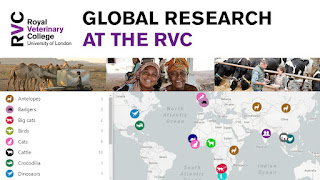 |
| Our searchable species map |
For the last few months we've been working on a complete overhaul of the Research section of our university website. This was put on hold for a few months due to the response to Covid but since August it's been the main focus of the team. The main rationale behind this was:
- To update and overhaul how our Research is showcased in line with the new structure outlined by the Vice Principal for Research and Innovation
- To focus on Impact and better showcase strategic projects in preparation for the forthcoming Research Excellence Framework (REF)
- To audit, rewrite and standardise all Research pages for better visibility on Google (and how people search)
- To improve the listings and cross-referencing of projects (by species, location, group, centre and researcher)
- To better highlight our people and the work they undertake across the institution
- To better showcase our external partners
We are an organisation who punch high above our weight with regards to both the profile of our research and the quantity we produce. Being a veterinary college means that this is all with a 'One Health' focus. In particular recognising that the health of people is closely connected to the health of animals and our shared environment. Our process for the new section was split into six key stages:
- Stakeholder interviews: We spent the first few weeks talking to key researchers and external partners to determine what was important for them strategically. This helped us to categorise our research output better, standardise the layout of a project and prioritise what was strategically important.
- Audit: We then went through our existing website to find what could be archived, transferred over and given greater prominenece. Our website and socil media analytics data helped us to determine how people searched so we could begin rewriting our content in a more SEO friendly way.
- Content strategy: Primarily, this was to allow us to have a sustainable website section which is regularly updated and monitored (not always the case in the past). We prioritised key projects (in line with REF) and ensured on launch every area of the College was equally represented and visually appealing with a mix of text, images and video.
- Templating: After creating a new site map we then created templates for different page types (eg. landing pages, projects and listings). We provided training to our researchers on these templates so that they would supply the content in an identical format. This meant the easy creation of tags for group, lab, species and location.
- Build: Whilst everything was scoped to be built in our existing CMS we sourced a new solution for our searchable species map. We chose MapMe as it was the most visually appealing and easy to use for editors. Then we created a project map outlining page types, responsibilites, deadlines and whether it was a new page or one being migrated over. It was then colour coded to show progress becoming pleasingly more green as time went on...
- Launch - This was a bigger job than anticipated and required a lot of remapping of URLs and Google Analytics goals
The addition of the species map was the main hook of this new section as it was a unique opportunity for us to highlight our global impact as a veterinary college. Internal and external feedback has been great with many researchers now coming forward to have their projects included.
So, did we achieve our objectives? The first month of analytics is very positive with an increase in visits by 103% and, most pleasingly, the dwell time on the page increasing by 86%. Let's hope we can continue to improve the section and do justice to the amazing work being done across the world!









